David & Jennie Curry's Camping Operations in Yellowstone & Yosemite
Copyright 2014 by Robert V. Goss. All rights reserved.
No part of this work may be reproduced or utilized in any form
by any means, electronic or mechanical, including photocopying,
recording or by an information storage and retrieval system
without permission in writing from the author.

|
DAVID A. CURRY DIES IN SAN FRANCISCO
May 5, 1917 Mariposa Gazette
David A. CURRY, founder of the first hotel camp in the Yosemite National Park, whose friends throughout the west number thousands, died Monday [April 30] of this week at the German hospital in San Francisco. Curry, known throughout the west as the "Stentor of Yosemite," was born in Indiana in 1860. He was a graduate of Indiana University and taught school in Utah for four years. He came to California in 1897-98 and a year later founded Camp Curry.
From a small beginning of seven tents in 1899, Camp Curry, under the direction of its genial manager, has grown into a tent city accommodating more than one thousand guests. Curry had just completed plans for the 1917 season when his untimely death occurred. His wife, Mrs. Jennie Curry, and three children, survive. The widow and son will manage the resort this year.
David Curry on mule in Yosemite, no date.
|
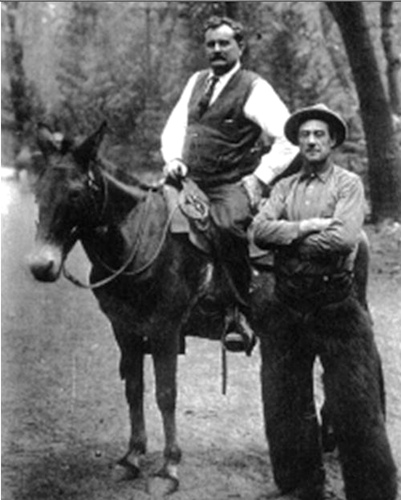 |
Biography & Early Life . . .
|
Moving backward in time we find that David Alexander Curry was born February 15, 1860, in Bloomington, Indiana, where he received his early education in the common schools of Monroe County and of Winchester, Kansas. He was an alumnus of Indiana University, graduating Bachelor of Arts in 1883. After graduating he engaged for several years in teaching, first in the common schools and later in the High School of Greensburg, Indiana.
In 1887 he was elected Assistant in the Latin Department of Indiana University, and during the college year 1888-89 took post graduate studies in Harvard University. He resigned in 1888 to commence studying for the ministry in the United Presbyterian Theological Seminary at Xenia, Ohio. Experiencing theological differences with the faculty, he left and joined with the Congregationalists.
On April 6, 1886, he married Miss Jennie Foster, of Bloomington, and their son David Foster Curry was born May 9, 1888. Jennie Etta Foster, born 1861 in Rushville, Ohio, was educated in the Knightstown Indiana High School. Receiving a Degree, B. L. Occupation from Indiana University, she taught in the Bloomington and Knightstown public school. She later served as principal of the Greensburg High School and taught for a time at Indiana University.
|
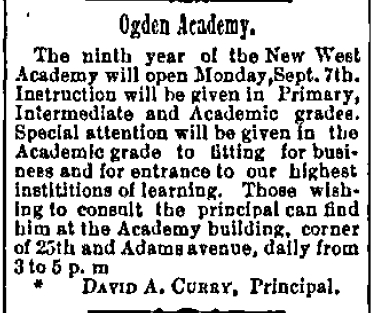
Ad for Ogden Academy
Ogden Standard Examiner
Aug. 28, 1891 |
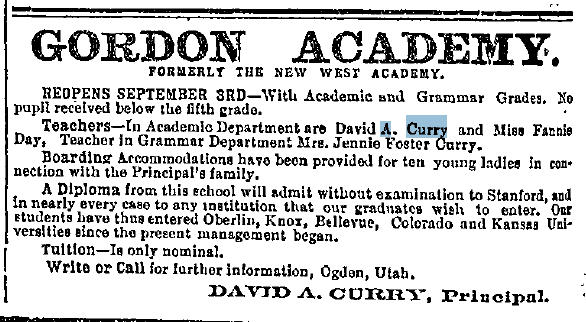
Ad for Gordon Academy
Ogden Standard Examiner
Aug. 22, 1894
|
In the fall of 1891 the Curry family moved to Ogden, Utah to teach in the Gordon Academy, founded by the Congregational Church as a learning refuge from local Mormon orthodoxy. Originally known as the Ogden Academy in 1883, it was also called the New West Academy. David became principal and Jennie taught at that institution for four years. Meanwhile the family continued to grow with the births of Mary Louise on November 29, 1893 and Marjorie Lucille on April 11, 1895.
The Curry family left Utah in 1895 and moved west to Palo Alto, California where a relative named Rufus Green was engaged with Stanford University. They were also acquainted with David Jordon, president of Stanford (and former president of Indiana University), where they hoped to take post-graduate work. Instead, through their contacts, David was able obtain a contract in the fall as principal of Sequoia High School in Redwood City while Jennie acquired a teaching position there. They stayed at Sequoia High until the summer of 1899 when the call of Yosemite beckoned . . .
|
Camping the Yellowstone . . .
Meanwhile, the summer after the Currys arrived in Ogden, they decided upon a camping adventure in Yellowstone National Park. While they made plans for this 1892 adventure, a number of their friends and fellow teachers made known their desire to go along. The Currys agreed to organize the trip and advertised in local papers in order to gather enough other participants make a party of 20. His ads solicited "Teachers, students and anybody of good character." Originally scheduled to leave June 27th for 17 days at a cost of $65 that included everything, an ad on June 26 cut the rate to $50 with a scheduled departure of July 4th. The group no doubt visited all of the popular tourist sites and sights in the park and camped at a variety of locations along their route. They apparently had a successful trip and arranged for a second expedition that season and became an annual affair for six more years.
By 1895 the operation had expanded to include 37 tourists, transported in five 4-horse covered wagons, one 2-horse wagon, three 4-horse baggage wagons, along with nine teamsters, a cook and four assistants. The entourage typically traveled from Ogden to Idaho Falls via the Oregon Short Line RR where they disembarked to continue the journey by wagon through the west entrance of Yellowstone. Although the Currys moved had moved to Palo Alto in 1895, they continued to return to Utah and conduct the Yellowstone camping trips through the 1898 season. |
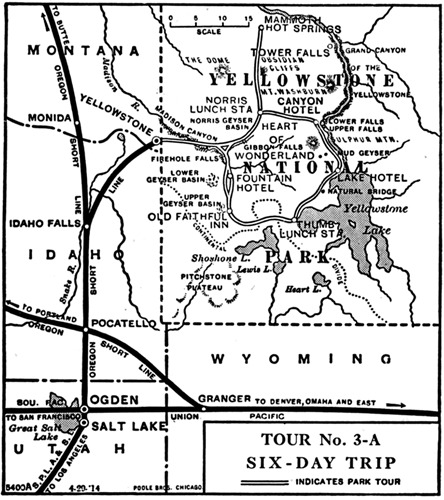
1914 map of Yellowstone and route from Ogden UT. The rail line shown from Idaho Falls to the West entrance of the park did not exist until late in 1907. |
|
Back From National Park
Incidents of Interesting Trip – Scenic Wonders of Yellowstone
Excerpts from the Ogden Standard Examiner, August 3, 1895
“Professor David A. Curry who returned yesterday morning from Yellowstone park whither he went in charge of the large camping party made up of all sections of the country was seen last evening by a Standard reporter. Mr. Curry expressed himself as pleased with the success of the trip and with the scenery witnessed along their route. The party left here July 15th [1895] and was the largest camping party that ever visited the park. From here [Ogden] to Idaho Falls the party went by rail and thence started on eastward by wagons. Arrangements had been made for five four-horse wagons and one two-horse wagon for passengers, besides three four-horse baggage wagons and with these the party proceeded comfortably and made good time.
“There were thirty-seven tourists in the party who together with the nine teamsters, the cook, and four assistants, made the party number more than half a hundred. In the park region the tourists stopped one or two days at each of the principal places of interest.
“Among the interesting incidents of the trip were several adventures with bears . . . . it is customary for them to come around the hotels and get food. The managers of the different hotels rather encourage them in this . . . . the bears, evidently mistaking the large camp for a substantial hotel, came down to it [the camp] on several occasions and proceeded to help themselves to such provisions as they could find. Naturally, their researches took them to the culinary department, and consequently the cook of the party did not enjoy the trip. The first night when these animals called the cook was at home but he suddenly recollected that he had business elsewhere and spent half the night on top of a covered wagon while several of the shaggy coated creatures rummaged about in his department, upsetting things generally and feasting on about eight pounds of cheese. The tourists were not even awakened as their tents were some distance from the scene of the depredations and the cook was probably to [sic] much frightened to make an outcry. The next eighteen pounds of cheese and a goodly portion of a twenty-five pound tin of butter went to show the bruin’s appreciation of Utah’s dairy product.”
|
Troubles in Wonderland . . .
The Yellowstone operation was not trouble free by any means. The Curry family encountered the same basic problem that William W. Wylie of the Wylie Camping Company had faced – that of obtaining permanent camps and acquiring operating permits that lasted longer than one season. There was no financial security in a year-to-year operation and not knowing for sure if the business could continue the following season was a huge liability. Lending institutions typically would not lend money for such operations with no guarantee of long-term viability.
The military administration, whose allegiance was typically aligned with the larger hotels, tolerated the camping companies only as a necessary evil and felt those operations were degrading to Yellowstone. The Yellowstone Park Association hotels, backed by the Northern Pacific RR, also exerted much pressure to eliminate their competitors. However, since the camping operations were highly popular with visitors, it was politically difficult to shut them down. Vacationers enjoyed the camping experience not only because of the lower touring costs than the hotel operations, but they took pleasure in the sense of increased camaraderie with their fellow travelers, the leisurely pace, and the feeling of being closer to nature. Although Wylie finally received permanent status for his camping operation in 1896, it would not be until 1913 that another camps company, Shaw & Powell, received permanent camp status. |
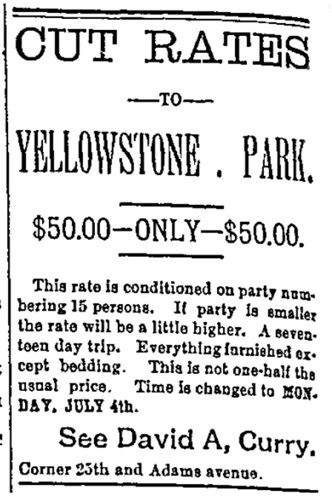
Ogden Standard Examiner,
June 27, 1892
|
|
The Ogden Standard Examiner, February 19, 1910 discusses David Curry’s setbacks and successes:
“There has developed within the last years a new industry, that of entertaining tourists in the national parks. The business is growing as a greater number of travelers enter the national reserves, attracted by the grandeur and beauty of the scenery and the novelty of “roughing it.”
“David A. Curry, formerly principal of Gordon Academy, Ogden, is bore as a reminder of the prosperity that comes to those who cater to the tourists in the parks. He has found the life of concessionaire more enticing that that of school teaching, although he was successful as a pedagogue.
“Mr. Curry has a camp in Yosemite, where for ten years; he has been entertaining the pleasure-seekers of California and the outside. Uncle Sam grants him the privilege of caring for not to exceed 200 guests. He hopes to increase the limit to 400, and then he will be happy.
“His first experience in this line of endeavor was obtained while he was a resident of Ogden. He conceived the idea of making his vacations profitable by personally conducting parties through the Yellowstone. That was when tourists left the railroad at Idaho Falls and before the line was constructed to the western gate of “Wonderland.” He escorted one party of 38 at a cost of $105 to each member, and made a profit of $700 on the venture, and there forth he saw less of charm in pouring over algebra, rhetoric and science, and resolved to be an owner of a camp in a national park.
“But to become a national concessionary, is to favored as few are favored. Mr. Curry says he would have continued his labors in the Yellowstone, but found the park monopolized by the Northern Pacific railroad and its representatives. Though supposedly a government reserve, in which equality is practiced, the Yellowstone was, to all practical purposes, the private property of the railroad and Mr. Curry is of the opinion that the entrance of the Oregon Short Line [UPRR] has done little to break down the barrier set against the man of small means who might be foolish enough to seek a foothold in the park . . . It would be well for a congressional committee to inquire into the monopoly of Yellowstone. No great government tract should be made to serve exclusively the commercial greed of a railroad or any other monopolistic interests.”
|
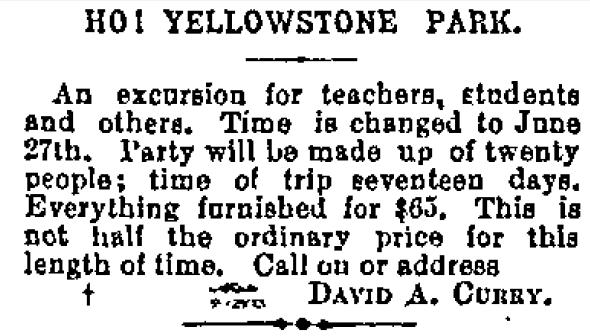 |
|
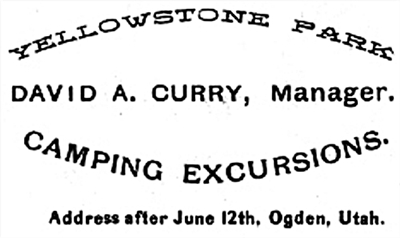 |
A New Vision Evolves . . .
With only 43 camp guests in 1897, frustrated in his endeavors to establish permanent camps, and unhappy with having to move his family back and forth between California and Yellowstone, David Curry finally gave up his Yellowstone expeditions after the 1898 season and began making plans for a different enterprise closer to home. He envisioned a new camp operation at Yosemite National Park, believing that “Yosemite is less in the control of large interests, and half a dozen camp concessionaires do well.”
Although still principal of Sequoia HS in 1899, he took steps to fulfill that dream. While waiting for the spring term to conclude, Curry sent cousins Rufus Green and Will Thomson ahead to Yosemite to pick out a camp site and make preliminary arrangements for the camp operation. The men chose a spot at the uncrowded east end of the valley near the base of Glacier Point. The views of the upper valley were superb, and its proximity to the major trailheads would prove to be advantageous in future years.
|
Map of route into the Yosemite area from San Francisco and nearby areas.
From "In the Heart of the Sierras by James M. Hutchings 1888."
|
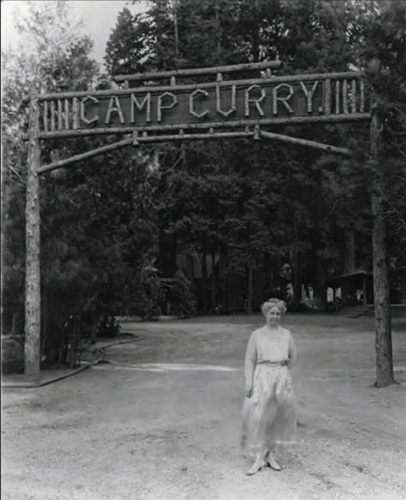 |
That first summer the camp consisted of seven sleeping tents and a larger one to serve as dining room and kitchen. The Curry family moved into the valley after the school session ended and with the assistance of only a cook and students from Stanford University working for room and board, put into place the beginnings of an enterprise that continues to this day. 290 people registered the first year and eighteen more tents were quickly added to handle the unexpected volume of business. Originally called Camp Sequoia, the name was shortly thereafter changed to Camp Curry. The camp continued to prosper and by 1922, Camp Curry had grown to 650 tents, 60 rooms in cottages, a cafeteria, a bakery, an ice plant, a candy kitchen, soda fountain, a studio, laundry, bathhouses, pool, auditorium, bowling alley, pool hall, a post office, and a store.
Left: Mother Curry ca1940.
|
|
Early Days at Camp Curry
This early history was penned for the 1964 Yosemite Centennial by Mary Curry Tressider, daughter of David and Jennie Curry. Mary Tressider quotes an account written by her mother in 1948:
"In the summer of 1899 David A. Curry and his wife Jennie Foster Curry, both Hoosier school teachers who had come west on the installment plan and finally landed in California, came to Yosemite and established a small camp for the entertainment of guests. They had formerly taken parties through Yellowstone with a movable camp. Both had been given an unusual love for nature and the out of doors through their training in nature lore under Dr. David Starr Jordan at Indiana University where they were both members and graduates of the class of '83.
They secured from the Guardian of the Valley (which was then a state park) permission to use the site of the present camp where with their first purchase of seven tents they began their enterprise. As everything had to be transported by wagon from Merced, a hundred miles away, their equipment was scanty-tents with burlap floors, bed springs on wooden legs, mattresses, comfortable and clean bedding, wash stands made from cracker boxes with an oilcloth cover and a calico curtain, a few chairs, and tables. The dining tent seated twenty persons.
The only paid employee was the cook, the remainder of the duties about camp being performed by Mr. and Mrs. Curry assisted by two or three Stanford students who worked a certain number of weeks in return for room and board and a week's free vacation in the park . . .
The seven tents grew during the first season to twenty-five and the number of guests reached almost three hundred which was considered a very good beginning . . . The guests came chiefly from educational groups, Mr. and Mrs. Curry being known to them through their teaching contacts. Each guest seemed to take a personal interest in the young concern and it was by their personal recommendations to their friends that Camp Curry - as the camp came to be called by its neighbors - had its immediate and steady growth."
|
|
Bird's-eye illustration of Camp Curry in Yosemite,
|
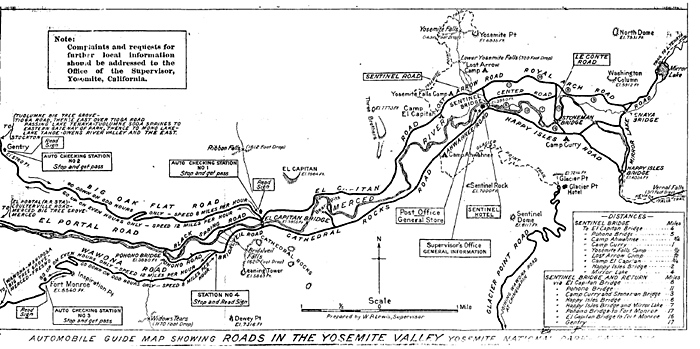
Map of Yosemite Valley from 1917 Auto Guide. |
Conclusion . . .
|
Unfortunately, David Curry would not live to see all of those changes noted in 1922. A serious blood infection in his foot developed from a rusty nail incident and he passed on April 30, 1917. Curry would be later remembered by his daughter as "big in body, mind and soul, interested in life and people, simple in his ways and habits, absolutely without any affection, his friendly spirit and genial whole-souledness appealed to people."
Jennie, affectionately dubbed Mother Curry, continued in charge of the camp with the aid of her family. Daughter Mary and husband Don Tressider eventually took over much of the day-to-day business while Jennie managed operations in the background. Both Jennie and Mr. Tressider died in 1948 and Mary assumed control of the company until her death in 1970, ending just over 70 years of management by the Curry family.
The company, which had became known as Yosemite Park & Curry Company in 1925, passed into the hands of the MCA Corp. in 1973. MCA/YP&CC lost the contract in 1992 due to majority ownership by a Japanese concern and Delaware North has run the operations since that time.
|
History of the Firefall . . .
|
The following is reprinted from from Yosemite Nature Notes, V. XIII, No. 6, June, 1934
by M.E. Beatty, Assistant Park Naturalist
The firefall is a distinctive and internationally known feature which even rivals the natural scenic attractions of Yosemite, so far as the average visitor is concerned. Most of our visitors who witness this impressive spectacle are desirous of knowing how the custom originated. Due to the meager information at hand, conflicting stories are oft times given out.
A description of the firefall follows for those not familiar with the practice. A bonfire is built nightly during the summer near the over-hanging rock at Glacier Point, 3254 feet above the valley floor. The wood for the fire consists mainly of red fir bark gathered during the day by a workman from down trees in the vicinity. Approximately one-quarter of a cord of wood is used for the larger bonfires. The pile of bark is ignited about 7 p.m. and a program conducted by a ranger-naturalist is held around the fire between 8 and 9. By 9 o’clock, the time of the firefall, the fire has been reduced to a glowing pile of embers.
The signal for the firefall is the extinguishing of the Camp Curry lights at the conclusion of their entertainment. The exchange of calls between Curry and Glacier may be heard from either place, and at the conclusion, the fire tender by means of a long handled shover, slowly pushes the glowing coals over the cliff. This gives the effect of a solid stream of fire, dropping some 1400 feet vertically to an oblique ledge, embers sometimes dropping along this ledge an additional 1000 or 1500 feet. There is no fire hazard as very little vegetation exists on the granite walls.
Our positive information starts in 1899, when Mr. and Mrs. David A. Curry established the Curry Camping Company at what is now Camp Curry. David Curry learned of the firefall custom, which had fallen into disuse and decided to revive it for the benefit of his guests. He would occasionally send one of his employees up the trail to Glacier Point to build the fire and push it off. This was done more and more frequently, until it became a nightly occurrence. Mr. Curry’s, “Hello, Glacier” and “Let the fire fall,” delivered with remarkable volume, won for him the title, “The Stentor of Yosemite.” This custom has been continued ever since, although David Curry has passed away.
In August 1928, the San Francisco Chronicle printed an article concerning Fred W. Zimmerman, who claims the distinction of originating the firefall. He was quoted as follows: My first trip to Yosemite Valley was in 1883. I came over the Big Oak Flat road in a buckboard pulled by two mules. One day, during that summer, I climbed to Glacier Point, two-thirds of a mile above Yosemite Valley. I decided to spend the night there. The weather became cold, so I gathered a pile of cones and built a fire. When the cones had burned down to red hot coals I grasped a long stick and amused myself by knocking them out into space. J.K. Barnard, who was manager of the Sentinel Hotel at the time, saw the flaming cones bouncing down the mountainside, spreading sparks in all directions as they came. He was very much pleased with the display. The following day he came to my camp near Half Dome and offered to pay me $2 per night if I would build a fire at Glacier Point and shove it from the precipice each night for the pleasure of his guests, I accepted.
Fred McCauley claims for his father, James McCauley, the same distinction. McCauley came to Yosemite Valley in the spring of 1870, after spending a number of years in the mines around Mariposa. In 1871, he was granted the privilege of building a trail to Glacier Point, what is now the four-mile trail.
In either 1871 or 1872 the idea of pushing the fire over the cliff was thought of and McCauley’s guests traveled to the floor of the valley to witness the spectacle. It was so successful and effective that many people requested more. The orders became so numerous that finally McCauley decided to make a charge of $1.50 for each firefall. This practice was continued irregularly for a number of years. In addition to pushing the fire over, McCauley would soak gunny sacks in kerosene, light them, and after waving them back and forth several times, throw them over the cliff.
|
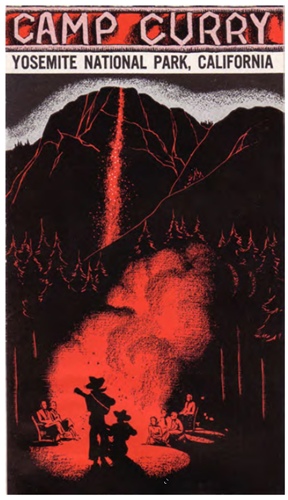
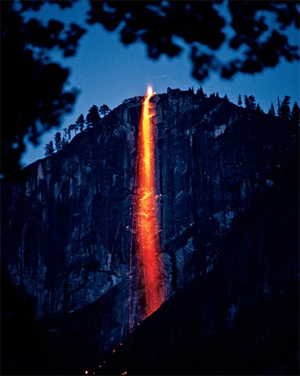 |
Copyright 2014 by Robert V. Goss. All rights reserved.
No part of this work may be reproduced or utilized in any form
by any means, electronic or mechanical, including photocopying,
recording or by an information storage and retrieval system
without permission in writing from the author.
|